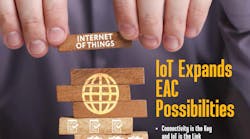The access control industry is in the midst of a grand convergence. The emergence and now dominance of IP-centric video surveillance technology has overtaken the world of analog and that migration is swiftly infiltrating today’s access control systems.
The attractive nature of network-based technology that has become a foundation of video systems is also the hook for IP access control solutions. The ability to customize an IP-based access control system with an integrated approach using several complementary vendors, while maintaining the flexibility to expand and scale a system to fit a customer’s needs provides both security and a sound ROI argument.
Yet, as IP-centric access control options grow, the potential for even more dynamic solutions are evolving as IoT capabilities expand. It is this convergence of traditional access control with networked IoT devices that is the future of security so says most of the industry’s technology experts.
“The advent of IP has definitely been a boon to ACS, leading to new innovation in terms of IP-connected door controllers and modules. It may not have driven the growth of IoT in terms of consumer devices, but has definitely had an impact on ACS and the strategy of ACS vendors,” says Jimmy Palatsoukas, Director of Product Marketing at Genetec.
Stuart Tucker, Vice President, Enterprise Solutions at AMAG Technology, adds that “by opening the communications between systems and devices using common easy to implement protocols, barriers have been removed. Once these barriers are out of the way, new technology can easily be integrated into IP-based solutions yielding new use cases.”
Peter Boriskin, VP of Commercial Product Management at ASSA ABLOY Americas stresses that the IP migration has allowed access control vendors to accelerate that deployment.
“Legacy systems that aren’t networkable require a dedicated hardwired connection to a central system or data gathering point, and there is only intelligence at the headend. With distributed intelligence, you can take advantage of device-to-device communication. This was really a precursor to IoT,” continues Boriskin. “These intelligent devices run their own IP, support intelligent controllers and a database of logic. With these systems where devices are already on the network, users are taking advantage of the available information.”
Michael Coniff, Global Product Marketing Manager at Honeywell points out that building environments are rapidly changing. He says that as property managers look to attract people to their facilities, there will continue to be a massive growth of technology use within buildings.
“This consumer-driven growth of IP is essentially going to make our buildings smarter and provide structured wiring that’s easier for people to take advantage of within a network. We’re seeing a rapid growth of interconnected buildings that are more advanced, as well as the growth of cutting-edge devices that are providing a plethora of information that managers can tap into,” says Coniff. “There is a general movement toward the adoption of technology from property managers, company owners, and building owners. These individuals are taking advantage of what they currently have, as well as replacing outdated devices with new, smarter solutions.”
Robert Martens, a futurist and Vice President of Strategy and Partnerships at Allegion stresses that the componentry necessary to deliver a robust connected user experience is less expensive, more capable and more easily supported than ever before.
“Sensor technology is relatively inexpensive and allows for the collection of great amounts of data. The pipes needed to transport that data are less expensive than ever and more dependable than ever. The tools that transform that messy data into cleaner, more usable information are more available, less expensive and faster than they have ever been. This all adds up to a strong cost/benefit equation that will help to drive the usage of IoT-enabled devices,” he says.
Jason Ouellette, Senior Product Line Director for Access Control at Tyco Security Products concludes that the rapid advancement of IP has enabled electronic access control solutions to become a part of the devices and data that can feed wider IoT solutions. “I wouldn’t say that access control has really paved the way for growth in IoT, but rather the industry is getting on the highway to IoT-based solutions, ensuring its relevance and compliance to overall IT industry and trends.”
So goes the theme of this supplement. I encourage you to flip to page 8 and read the complete technology trends roundtable we hosted for these vendors. It is both enlightening and entertaining.
Steve Lasky is the Editorial Director of SouthComm Security Media, which includes print publications Security Technology Executive, Security Dealer & Integrator, Locksmith Ledger Int’l and the world’s top security web portal SecurityInfoWatch.com. He is a 30-year veteran of the security industry and a 26-year member of ASIS.



